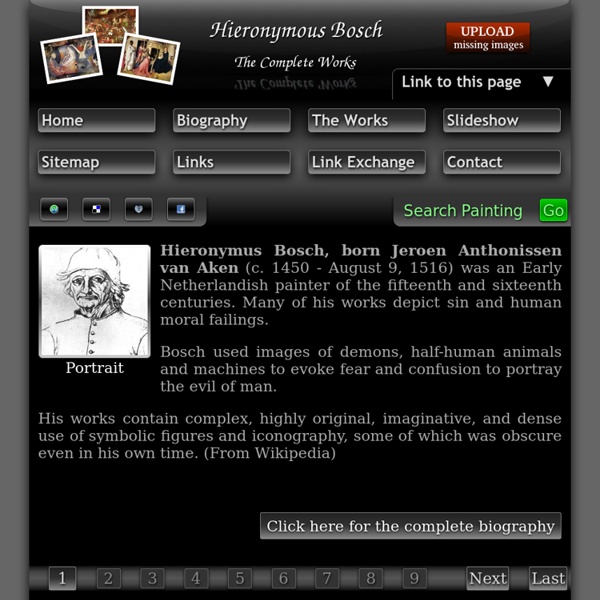



J rome Bosch,Le Jardin des D lices,1480,1490,Triptyque,analyse et etude de la toile et du style,art,culture,peinture. Laisser un commentaire ou un avis. Jérôme Bosch. (1450-1516). Le Jardin des Délices, (1480-1490). Triptyque. Fermé : 1,94 m x 1,95 m. Triptyque ouvert la règle des tiers divise l’œuvre en 9 scènes différentes, en réalité on en compte bien plus. Jérôme Bosch. Par rapport au premier triptyque du Dernier Jugement la palette du peintre est plus riche, plus claire, le contraste entre couleurs chaudes et froides est accentué. Panneau de gauche : 97 cm x 1,95m. Sur ce panneau, Bosch représente le Paradis où se tiennent le créateur, Ève et Adam. Le point de vue du spectateur se situe à peu près au centre au niveau de la fontaine. L’œuvre est construite sur la diagonale ascendante. Au milieu du bassin central, sur un îlot, se dresse la fontaine de la connaissance. A coté du bassin, sur la droite se trouve l’arbre de la tentation. A l’arrière plan se trouvent de grandes tours peuplées d’oiseux au milieu des arbres. Le panneau est plus sombre, au premier plan Adam et Ève sont chassés du paradis.
Hieronymus Bosch, Jardin des Delices Peinture de l´Arbousier, Arbre à Fraises Premier appellatif de ce retable. L´arbousier ou Arbutus unedo, nom qui se traduit du latin ainsi: Arbuste duquel on ne mange que le fruit, Le haut contenu alcoolique de ses bayes mûres qui souffrent une fermentation rapide, enivre vite fait. Une légende raconte que du sang du géant Géryon, vaincu par Héraclès, naquit cet arbre qui donne ses fruits sans pépin au moment où se montrent les Pléiades. Pour les romains il était sacré et dédié à la nymphe Cardea ou Carna, amante de Janus,( protagoniste de l´âge d´or avec Saturne) laquelle protégeait le seuil des maisons. L´arbousier est aussi appelé l´ARBRE DE CAÏN…nom dû sûrement à l´ivresse qu´il procure à celui qui en mange en excès et les conséquences de cet état. C'était aussi un symbole d'éternité grâce à son feuillage toujours vert et à ses fruits naissant en plein hiver. mais la bruyère n'hésita pas à dénoncer son voisin l'arbousier et Jésus fut capturé. Et Jérôme Bosch dans tout ça ? Le 11
Van Gogh Starry Night Hieronymus Bosch Posthumes Porträt Boschs (um 1550), Jacques Le Boucq zugeschrieben Hieronymus Bosch [ɦijeːˈɾoːnimʏs ˈbɔs] (eigentlich Jheronimus van Aken [jeɪˈɾoːnimʏs vɑn ˈaːkə(n)]; * um 1450 in ’s-Hertogenbosch; † August 1516 ebenda) war ein niederländischer Maler der Renaissance. Er hat ein bis heute faszinierendes und nachwirkendes Gesamtwerk hinterlassen, das sich in der Interpretation jeder einfachen Deutung entzieht. Herkunft und Namen[Bearbeiten] Hieronymus Bosch entstammte der Malerfamilie „van Aken“, deren Herkunftsname darauf verweist, dass die direkten Vorfahren in der väterlichen Linie aus Aachen stammen. Hieronymus benannte sich nach seiner Heimatstadt, die auch Den Bosch genannt wird. Leben[Bearbeiten] Hieronymus Bosch wurde erstmals 1474 urkundlich erwähnt. 1481 heiratete Bosch die Patriziertochter Aleyt Goyaert van de Mervenne, die ein Haus sowie ein Landgut in die Ehe einbrachte. Die Welt des Hieronymus Bosch[Bearbeiten] Das Werk[Bearbeiten] Der Wanderer (1490–1505) Die Symbole[Bearbeiten]
guernica Analyse de GUERNICA GUERNICA a été réalisé par Picasso en 1937. Celui-ci s'est inspiré du bombardement de la petite ville basque de GUERNICA, le 26 avril 1937, par l'aviation allemande au service de Franco. Guernica était une commande du gouvernement républicain espagnol pour le pavillon à l'Exposition Universelle de Paris de juillet 1937. Picasso, à travers ce tableau, symbolise l'horreur des conflits humains. "La peinture n'est pas faite pour décorer les appartements; c’est une arme offensive et défensive contre l’ennemi", c'est ce que déclara Picasso à propos de Guernica. Les Caractéristiques : Guernica est une huile sur toile mesurant 7 m 52 de long sur 3 m 51 de largeur. Analyse des différents symboles du tableau : Tout d'abord, au centre du tableau, la lampe. Le taureau à gauche est l'incarnation de la brutalité, de l'obscurité dans la corrida. Le cheval, quant à lui, incarne la victime innocente de cette corrida. La colombe symbolise la paix. Le soldat, on le voit l'épée brisée.